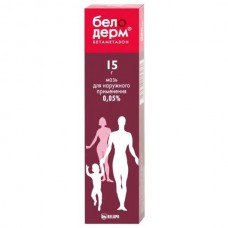Expiration date: 11/2026
The composition and form of issue:
Cream for external use 0.05%. 1 g contains:
betamethasone dipropionate 0.64 mg
(equivalent to 0.5 mg betamethasone)
excipients: chlorocresol sodium dihydrogen phosphate monohydrate phosphoric acid petrolatum mineral oil macrogol cetostearyl cetostearyl alcohol sodium hydroxide purified water
in the aluminium tubes to 15 or 30 grams in a box 1 tuba.
Ointment for external use 0.05%. 1 g contains:
betamethasone dipropionate 0.64 g
(equivalent to 0.5 mg betamethasone)
excipients: mineral oil, petrolatum
in the aluminium tubes to 15 or 30 grams in a box 1 tuba.
Description pharmaceutical form:
The topical cream: white homogeneous cream, free from mechanical inclusions.
Ointment for external use: white, translucent, homogeneous ointment.
Feature:
GKS for external use.
Pharmacological action:
When applied to the skin surface, the drug has a rapid and strong effect in the inflammation, reducing the severity of objective symptoms (erythema, edema, lichenification) and the subjective sensations (itching, irritation, pain).
Indications:
- atopic dermatitis
- dermatitis: atopic, allergic, contact (including professional) and other non-allergic dermatitis (including solar and radiotherapy)
- reaction to insect bites
- eczema (various forms)
- psoriasis
- bullous dermatoses
- diskoidna lupus erythematosus
- lichen planus
- exudative erythema multiforme
- itching of various etiologies.
Contraindications:
- hypersensitivity to betamethasone or to other components of the drug
- tuberculosis skin
- cutaneous manifestations of syphilis
- varicella
- viral infection of the skin, skin post-vaccination reactions
- open wounds, trophic ulcers
- rosacea, acne vulgaris
- children up to age 6 months.
Application of pregnancy and breast-feeding:
Perhaps if the expected effect therapy outweighs the potential risk to the fetus, but only briefly and in small areas of the skin. In the period of breastfeeding only on strict indications, but never apply on the skin before feeding.
Side effects:
Are of a slight character. Rarely (as with the use of other corticosteroids) may develop hypersensitivity reactions (itching, burning, redness), acne-like changes, hypopigmentation, striae, skin atrophy, hypertrichosis, telangiectasia, secondary skin infection.
In the event of hypersensitivity reactions or side effects therapy should be discontinued and consult a doctor.
Drug interactions:
Unknown.
Method of application and dose:
Topically applied to the affected area of skin, thin layer, slightly vtiraya, 2 times a day. In areas with tighter skin (elbows, hands, feet), as well as places from which the drug is easy to wash, it can be applied more often. The duration of continuous treatment is usually not more than 4 weeks. For relapse prevention in the treatment of chronic diseases, treatment must continue for some time after disappearance of all symptoms. During the year, it is possible to repeat therapy.
In the form of a cream the drug is intended for therapy of acute, including weeping skin lesions. Ointment used for the treatment of subacute and chronic dermatoses, including dry, lichenizirovannah and scaly lesions or in cases when occlusive effect is required.
Overdose:
During long-term continuous use of the drug, especially in children, on large surfaces of skin, applied to the skin with impaired integrity or when used under occlusive dressing, may develop side effects associated with suppression and failure of function of the adrenal cortex.
Treatment: cancel the drug, symptomatic therapy.
Special instructions:
The preparation is intended for external use only.
We do not recommend prolonged use of the drug on the skin because the rosacea, perioral dermatitis and acne.
It should not be used in the eye area, in regard to the probability of getting the drug on mucous membranes that may contribute to the development of cataract, glaucoma, fungal eye infections and exacerbation of herpes infection.
Some areas of the body (axilla, inguinal folds), where there is natural occlusion are more vulnerable to the risk of striae, therefore, the use of the drug in these sections should be short.
In the case of a fungal or bacterial infection on the skin, it is necessary the additional use of antifungal or antibacterial agents.
During long-term continuous use of the drug, especially in children, on large surfaces of skin, applied to the skin with impaired integrity or when used under occlusive dressing, may develop systemic side effects, but the probability of this is extremely small.
Application in Pediatrics. You can assign children (from 6 months) with caution and for a short period. You should not use the drug to children under the bandages and especially plasticized diapers, because it enhances the absorption of the drug and increases the risk of side effects.
Effects on ability to drive vehicles and mechanisms. Does not affect the ability to drive vehicles and mechanisms.






